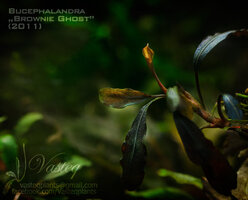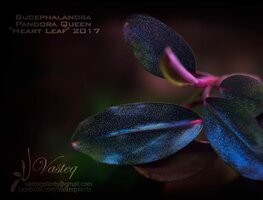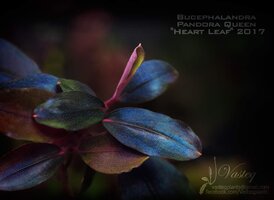Hello. I am a breeder and lover of rare aquarium plants, mainly Bucephalandra. For many years I have been acquiring the most interesting varieties from other collectors from around the world. I would like to present you a gallery of my plants. I hope you like it.
Akatha „Dark”
An interesting variety that can compete with the amazing Semadang. It resembles it very much in color, shades, size and stiffness of the leaves. Only the shape of the leaves is more pointed.

Brownie „Red-True”
Based on the color of the leaves, it should be called Brownie „Black-True”. Original from Mr. Nakamoto. I have never seen leaves so black. At the right angle, the black shimmers with a blue glow. This is the only time when the color of the leaves is lighter than black.




„Black Skull”
If you like the dark look of the „Achilles” and the majestic look of the roundleaf „Emerald [East Borneo]” then you will love this variety. „Black Skull” is one of the most interesting proposals of recent years.


Brownie „Ghost” 2011
One of the oldest, rarest and prettiest Bucephalandra species. The original one comes from NK (2011 year).
The amazing advantage of this variety is its outstanding colors. Under favorable conditions in the aquarium, new leaves appear with a bloody red color and older leaves take on a dark blue or purple color.
In addition to it, there is another similarly colored variety. Brownie „Red”. The difference between them is that „Ghost” has more slim leaves and „Red” has roundish leaves. As far as I know, the origin of the name is that this variety appeared at the beginning in one place, then disappeared and now it is difficult to find it in nature. It is said that it is found only in hobbyist aquariums.






Hygrophila Difformis „White-Green”
There is also a rare variegated variety that grows fairly quickly under water. Imported by eastern collectors of rarities


Ludwigia Sphaerocarpa „Mini”
A slow-growing, dwarf variety of one of the most interesting Ludwiga. Slow growth under water makes it possible to obtain only a few cuttings per year. It grows low to the ground in Hightech aquariums, while in Lowtech aquariums it can be much taller, it is not as stunted and its growth rate is even slower. In good lighting conditions, it takes on red-orange colors.



Anubias „Micro”
Personally, I think it's one of the smallest anubias I've ever met. It is an extremely resistant plant that can survive even in the harsh conditions of the aquarium. Its growth rate is extremely slow. Her origin is unknown. I got it from a collector in the Czech Republic who got it along with other anubias and this one grew differently and maintains its growth form for many years.










Akatha „Dark”
An interesting variety that can compete with the amazing Semadang. It resembles it very much in color, shades, size and stiffness of the leaves. Only the shape of the leaves is more pointed.

Brownie „Red-True”
Based on the color of the leaves, it should be called Brownie „Black-True”. Original from Mr. Nakamoto. I have never seen leaves so black. At the right angle, the black shimmers with a blue glow. This is the only time when the color of the leaves is lighter than black.




„Black Skull”
If you like the dark look of the „Achilles” and the majestic look of the roundleaf „Emerald [East Borneo]” then you will love this variety. „Black Skull” is one of the most interesting proposals of recent years.


Brownie „Ghost” 2011
One of the oldest, rarest and prettiest Bucephalandra species. The original one comes from NK (2011 year).
The amazing advantage of this variety is its outstanding colors. Under favorable conditions in the aquarium, new leaves appear with a bloody red color and older leaves take on a dark blue or purple color.
In addition to it, there is another similarly colored variety. Brownie „Red”. The difference between them is that „Ghost” has more slim leaves and „Red” has roundish leaves. As far as I know, the origin of the name is that this variety appeared at the beginning in one place, then disappeared and now it is difficult to find it in nature. It is said that it is found only in hobbyist aquariums.






Hygrophila Difformis „White-Green”
There is also a rare variegated variety that grows fairly quickly under water. Imported by eastern collectors of rarities


Ludwigia Sphaerocarpa „Mini”
A slow-growing, dwarf variety of one of the most interesting Ludwiga. Slow growth under water makes it possible to obtain only a few cuttings per year. It grows low to the ground in Hightech aquariums, while in Lowtech aquariums it can be much taller, it is not as stunted and its growth rate is even slower. In good lighting conditions, it takes on red-orange colors.



Anubias „Micro”
Personally, I think it's one of the smallest anubias I've ever met. It is an extremely resistant plant that can survive even in the harsh conditions of the aquarium. Its growth rate is extremely slow. Her origin is unknown. I got it from a collector in the Czech Republic who got it along with other anubias and this one grew differently and maintains its growth form for many years.










Attachments
Last edited:





















